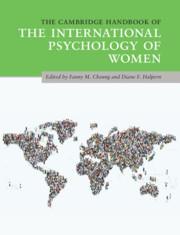Book contents
- The Cambridge Handbook of the International Psychology of Women
- The Cambridge Handbook of the International Psychology of Women
- Copyright page
- Dedication
- Contents
- Figures
- Tables
- Contributors
- Acknowledgments
- Section 1 The Underpinnings of Sex and Gender and How to Study Them
- Section 2 Developmental Perspectives of the International Psychology of Women
- Section 3 Cognitive and Social Factors
- Section 4 Work and Family Issues
- Section 5 Inequality and Social Justice
- 26 Girls, Boys, and Schools
- 27 Understanding Gender Inequality in Poverty and Social Exclusion through a Psychological Lens
- 28 Understanding Women’s Antisocial and Criminal Behavior
- 29 Sexual Assault
- 30 Intercultural Relationships, Migrant Women, and Intersection of Identities
- Section 6 Health and Well-Being
- Epilogue Some Final Thoughts and Take-Home Messages
- Index
- References
29 - Sexual Assault
from Section 5 - Inequality and Social Justice
Published online by Cambridge University Press: 20 July 2020
- The Cambridge Handbook of the International Psychology of Women
- The Cambridge Handbook of the International Psychology of Women
- Copyright page
- Dedication
- Contents
- Figures
- Tables
- Contributors
- Acknowledgments
- Section 1 The Underpinnings of Sex and Gender and How to Study Them
- Section 2 Developmental Perspectives of the International Psychology of Women
- Section 3 Cognitive and Social Factors
- Section 4 Work and Family Issues
- Section 5 Inequality and Social Justice
- 26 Girls, Boys, and Schools
- 27 Understanding Gender Inequality in Poverty and Social Exclusion through a Psychological Lens
- 28 Understanding Women’s Antisocial and Criminal Behavior
- 29 Sexual Assault
- 30 Intercultural Relationships, Migrant Women, and Intersection of Identities
- Section 6 Health and Well-Being
- Epilogue Some Final Thoughts and Take-Home Messages
- Index
- References
Summary
Sexual assault, including unwanted sexual contact, coercion, and rape, is a social phenomenon that has been approached in a variety of ways in different global contexts. Attempts to address risk and protective factors for perpetrators and victims are limited by the difficulty of collecting empirical data on experiences that can be traumatic, stigmatizing, complicated, and private. This chapter explores current and historic definitions of sexual assault as well as how these definitions influence estimates of sexual assault prevalence and subsequent psychological and public health responses. We describe best practices in sexual assault measurement, explore the need for culturally acceptable interventions that acknowledge intersections of identity, critique current victim response services, and finally provide recommendations for future directions in sexual assault prevention and response.
Keywords
- Type
- Chapter
- Information
- The Cambridge Handbook of the International Psychology of Women , pp. 417 - 433Publisher: Cambridge University PressPrint publication year: 2020
References
Suggested Readings

Mary Koss is a Regents’ Professor in the Mel and Enid Zuckerman College of Public Health at the University of Arizona. She published the first national study on sexual assault among college students in 1987. Half of the campus surveys from 2000 to 2015 used the survey developed for that study and most others were modeled on it. She was the principal investigator of the RESTORE Program, the first restorative justice program for sex crimes among adults that was quantitatively evaluated. She has consulted widely, most recently with the National Academies of Sciences, Engineering and Medicine. She has received the Award for Distinguished Contributions to Research in Public Policy (2000) and the Award for Distinguished Contributions to the International Advancement of Psychology (2017) from the American Psychological Association. Koss was born in the USA and has traveled widely. She received her BA from University of Michigan and her PhD from the University of Minnesota. She has held visiting scholar positions in Australia and Israel. She served on the advisory board of the Sexual Violence Research Initiative based in Johannesburg.

Maj Hansen is an Associate Professor and head of the research group THRIVE at the Department for Psychology, Southern University of Denmark. She was born and studied in Denmark. Her research is primarily focused within clinical psychology, specifically within areas of prevention, screening, and treating victims following traumatic exposure including interpersonal violence. Hansen is associate editor of the European Journal of Psychotraumatology and a member of the National Research Network on Violence against Children in Denmark.

Elizabeth J. Anderson is a gender and youth development researcher at the International Center for Research on Women. Born in the United States, she attended college at University of Missouri-Columbia and graduate school at University of Arizona. She has worked globally (including Mozambique, Croatia, Brazil, and Jordan) and locally on primary and tertiary HIV/AIDS prevention projects with women. Her research focuses on exposure to intimate-partner sexual violence as an epidemiological risk factor for infectious disease. Her work in Arizona focuses on primary and tertiary HIV/AIDS prevention projects employing mHealth approaches

Maria Hardeberg Bach is a PhD Fellow at the Department for Psychology, Southern University of Denmark. Her research interests include topics related to sexual violence. Maria was born in Norway, and lived in many countries during her youth including the Dominican Republic, USA, Indonesia, Brazil and Denmark. She completed her MSc in Psychology in Denmark in 2017 and her thesis focused on child sexual abuse. Shortly thereafter, she began her position at the University of Odense. She is currently conducting a series of qualitative interview studies about formal help-seeking among adult survivors of sexual assault from underserved and marginalized groups.

Rikke Holm Bramsen received her PhD from Aarhus University, and served as an Associate Professor at the Department for Psychology, Southern University of Denmark. Bramsen’s research includes various aspects of interpersonal violence, with a specific focus on the interdisciplinary organization of rape crisis centers. At present, Bramsen is the director of the Danish Children Center in Aarhus, Denmark. She is also a member of the National Research Network on Violence against Children in Denmark. She has lived in several countries outside Denmark, including Italy, the UK, and the United Arab Emirates.



